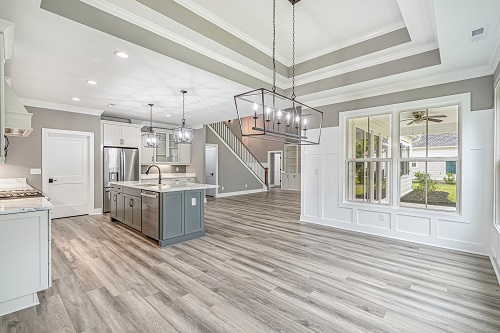
A rising home price might make it seem more affordable for first-time homebuyers to purchase land and hire contractors to build their homes. What is involved in building your first home? What’s the process involved in the construction of a custom home?
This project is not for the faint-hearted. It is quite different to build a house from scratch than to buy and move into an existing home. Learn everything you need about the pros and cons of new construction, financing options, timelines, and costs.
The Pros
You can customize your needs.
You can design your custom built home from the foundation up to the roof and create a space that is uniquely yours.
Flexibility: You can’t leave some rooms and extras unfinished. This allows you to save money by not having to finish them later, or even handle them yourself.
You can create an energy-efficient, low-maintenance home with the right design and the proper inspections. This will avoid the surprises that may occur in older homes.
The Cons
Long lead times: It takes time to buy land, obtain financing, permit approvals, and construct.
Supply chain problems: Delays, higher costs, and altered plans for home finishes or features may result from manufacturing and shipping issues.
Land buying can be difficult: There are potential pitfalls that could affect your timeline, costs, and timeline.
Potential labor shortages: It is possible for a project to be delayed due to a lack of skilled laborers. Significant delays could occur if there is a labor shortage because of high construction demand.
What is the Cost of Building a House?
The National Association of Home Builders said that the median sale cost of a new house was $436,000. This is more than 21% higher than the March 2021 month. This is only slightly less than the median house price in the United States, which was $428,700 at the end of the first quarter of 2022.
An NAHB survey of builders found that major construction costs include the following:
- Framing
- Inspections and fees
- Excavation
- Exterior finishes
- Major systems (plumbing and electrical, heating and cooling)
- Outdoor structures and landscaping
According to the survey, interior finishes account for the largest portion of new construction costs. This includes painting, insulation, drywall, lighting, and appliances.
How to finance a new build as a first-time homebuyer
In most cases, you will apply for a loan to finance your new home construction. The loan type and lender will have different requirements and conditions. Construction loans are not available from all lenders because there are risks associated with delays and uncertainty. They also have higher interest rates or floating rates than conventional loans.
The Homebuilding Process
It is crucial to talk with vendors to find out about delays in your local area before you start building a home. This will help you set realistic expectations regarding time frames. Homes built by general contractors on land owned by the owner took an average of 9.4 months to complete in 2021.
These steps will help you plan for the future.
Apply for a Loan
If you don’t have the cash to finance the whole project, you should start arranging to finance. To build a house, you should be prepared to finance at least four times the value of your lot.
Ask the lender at the application stage if they offer a single or multiple close construction loan. A single-close loan will typically lock in your interest rate upfront and then convert to a standard home mortgage once construction is complete. Multiple close loans will finance your construction starting with the first close. Then, you will close the second close with a new market rate.
Create a team of experienced professionals including a custom home builder
First-time buyers can be guided through the entire process of building a home from the moment they find the land to the day when closing. A professional real estate agent will help them. You can ask around for recommendations from homebuilders. Make sure that your contractor has insurance and a contractor license.
Design Your Custom Home
Your architect or builder can help you plan your dream home. Your custom home builder might need to modify plans purchased from another source to comply with local building codes. Warrick points out that codes can differ greatly. Plans drawn in one state may have 2-by-8 floor joists while the local code requires 2-by-10.
Design features that can be difficult to modify later like the ceiling heights should be prioritized. Before you spend money on cosmetics, make sure that the structure of your house is in good condition. You can remodel rooms, finish floors, add cabinets, paint, or upgrade light fixtures.
Get permits and start construction
Construction documents and permit processing can take anywhere from four to eight months depending on where you live. The timeline for building a home depends on its size, scope, location, and finish. A new build with landscaping can take up to eight months.
If you require a variance (which is common for custom-built construction), it may take longer. You may need a permit depending on where you are building or what might be on the lot. These delays can be avoided or predicted by an architect or real estate lawyer who is familiar with the local area.
Close the Closing
The new home is issued a certificate of occupancy after a final inspection. It is a good idea, however, to have an independent inspector inspect the house before you close the deal.
Call Dawol Homes now if you are looking for experts who can help build your home.
Like our Facebook page for more great info about new home construction.
Dawol Homes
9404 Hwy 17 Bypass,
Murrells Inlet, SC 29576
(843) 294-2859
http://www.dawolhomes.com/
info@dawolhomes.com
No comments:
Post a Comment